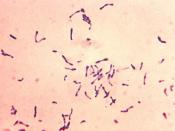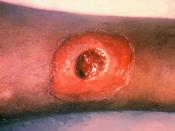Corynebacteria are Gram-positive, aerobic, nonmotile, rod-shaped bacteria related to the
Actinomycetes. They do not form spores or branch as do the actinomycetes, but they
have the characteristic of forming irregular shaped, club-shaped or V-shaped
arrangements in normal growth. They undergo snapping movements just after cell
division which brings them into characteristic arrangements resembling Chinese letters.
The genus Corynebacterium consists of a diverse group of bacteria including animal and
plant pathogens, as well as saprophytes. Some corynebacteria are part of the normal flora
of humans, finding a suitable niche in virtually every anatomic site. The best known and
most widely studied species is Corynebacterium diphtheriae, the causal agent of the
disease diphtheria.
History and Background
No bacterial disease of humans has been as successfully studied as diphtheria. The
etiology, mode of transmission, pathogenic mechanism and molecular basis of exotoxin
structure, function, and action have been clearly established. Consequently, highly
effective methods of treatment and prevention of diphtheria have been developed.
The study of Corynebacterium diphtheriae traces closely the development of medical
microbiology, immunology and molecular biology. Many contributions to these fields, as
well as to our understanding of host-bacterial interactions, have been made
studying diphtheria and the diphtheria toxin.
Hippocrates provided the first clinical description of diphtheria in the 4th century B.C.
There are also references to the disease in ancient Syria and Egypt.
In the 17th century, murderous epidemics of diphtheria swept Europe; in Spain 'El
garatillo' (the strangler'), in Italy and Sicily, 'the gullet disease'.
In the 18th century, the disease reached the American colonies and reached epidemic
proportions in 1735. Often, whole families died of the disease in a few weeks.
The bacterium that caused diphtheria was first described by Klebs in 1883, and was
cultivated by Loeffler in 1884, who applied Koch's postulates and properly identified...


